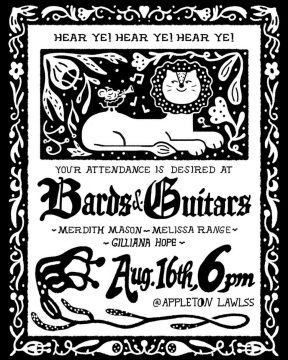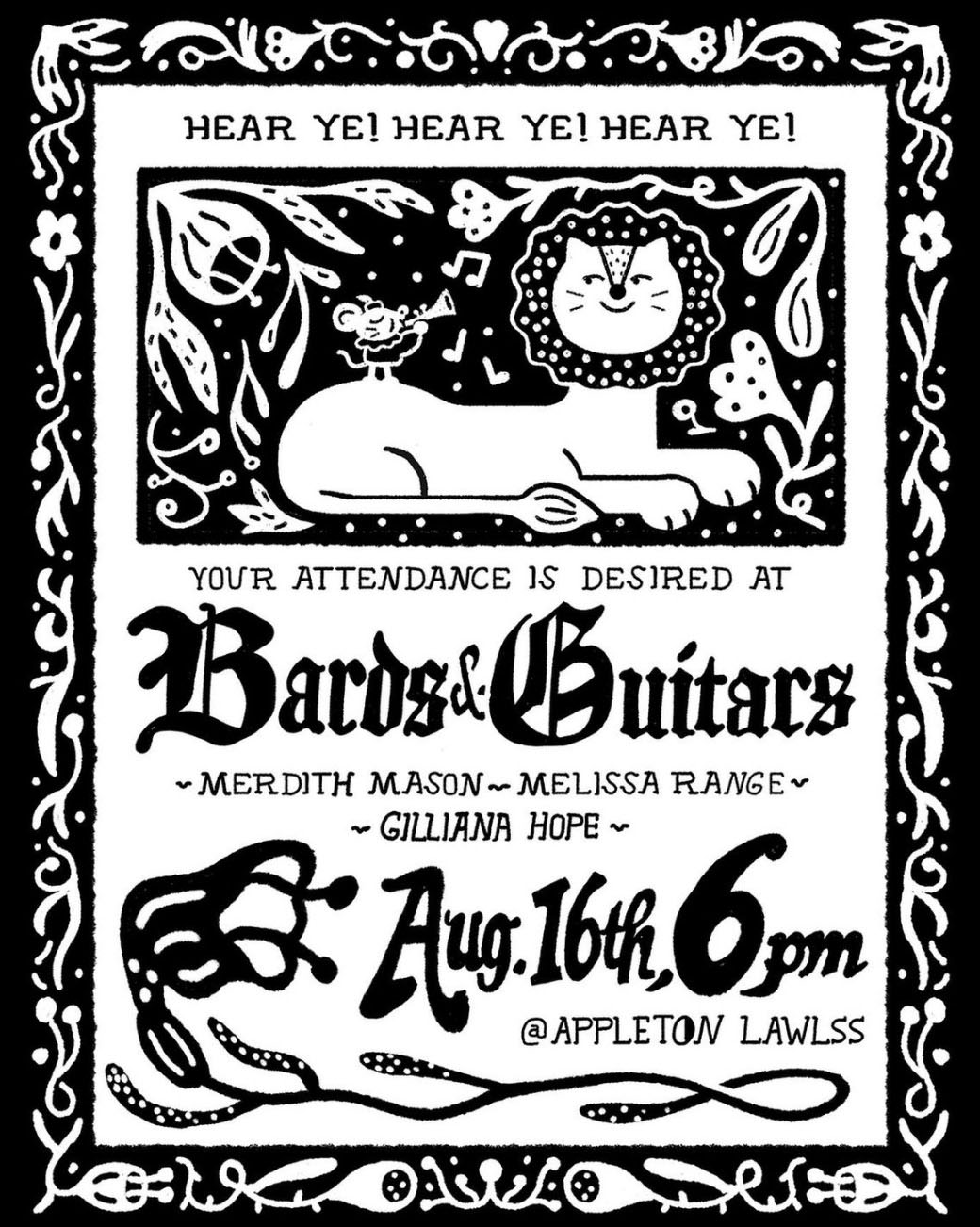This summer, just by walking through the door of Lawlss Coffee on the third Friday of each month, one would have been immediately swept up by the intimate but passionate energy shared by both artists and attendees of the Bards & Guitars event series. This series was the brainchild of Assistant Professor of English Austin Segrest and local poet Chloé Allyn and featured local creatives who shared works of poetry, song and more. The first time the series called out “Hear ye! Hear ye!” to the Appleton community was this May, where it was hosted at The Draw, before moving to Lawlss the next month.
Among the many “bards” who performed was singer-songwriter senior Miranda Lile. Lile was invited to share her work at the June session of Bards & Guitars by Segrest, who had had her in classes before. Naturally, Lile happily accepted. Her Bards & Guitars setlist included three unreleased songs that Lile had written herself. Also performing that night was junior Billy Greene, whom Lile had known since middle school. The two decided beforehand they would make a cameo in each other’s acts, with Greene performing one of Lile’s songs and Lile in return joining Greene for some joint poetry.

Performing, especially performing something that has never been performed before, is not an easy feat. Nobody knows that better than Lile, who admitted she tends to get nervous before taking to the stage. That night in Lawlss on Friday, June 28 was no different, especially because her live performances are few and far between. As she got on stage, however, she remembered the relief that washed over her as she let it all out. After all, to her, one of the best parts of creating music is getting to share it live with an audience, especially for the first time. The other part is having that audience engage with it right back.
“It’s always lovely to have people come up afterwards and say ‘this really connected with me’ or ‘I related to this part,’ which, in turn, helps the songs grow into their own thing through their relationship with other people,” Lile said. Lile chose the songs she did to best express her values and mark her musical growth. Since audience engagement is something she strongly believes in, her song “The Last of Us” was an obvious choice for the setlist; she remembered having a similar experience performing a Tiny College Concert, where the song had a chance to grow with a participatory audience. With “The Last of Us” solidified on the setlist, she moved on to choose the others. Lile said the songs “Whispers” and “Small Changes” stood out to her because they were the best representations of her new music, which she described as “folk-adjacent/ dark folk” and more inherently performable — “more universal […] less small-scale,” she called it — than her other works.
If audience engagement was what she was aiming for, her Bards & Guitars performance was a great success; several people approached her afterwards to introduce themselves and comment on her work. Lile considered it a great experience for her on many other fronts, too, as both a person and an artist.
“It was really nice to have an opportunity to be recognized as a musician by a professor that I respect, to share my new music and also to get to share myself as a poet,” Lile said.
Of course, getting to experience the other creatives was also an avenue to growth, according to Lile, who said she is always inspired by others passionately engaging with
art. “There’s a saying in choral music — your breathing starts to align, your heartbeats start to align […] it’s kind of like that,” Lile summarized. “Everyone is committing to this calm, passionate, art-forward environment and giving a space to people who are creating, inspiring, being inspired.”
Lile and Greene were not the only Lawrence students to perform; the August session welcomed junior singer-songwriter Gilliana Hope to the stage. Hope had performed in an event last summer where she connected with Allyn. Since she was going to be in the area for the August Bards & Guitars, she reached out to Allyn about performing and was approved to do so.
Hope’s setlist was her usual musical lineup for events like this, consisting of about six to seven songs, including a song called “Snapshots” that she wrote at Björklunden and a cover of Gracie Abrams’s “Blowing Smoke.” Though she considers labeling her musical sound to be a limitation to her artistic expression, she explained her style to be a “born-out-of-a-bedroom” kind of soft indie/folk. Many of her works, including two in her setlist for Bards & Guitars, titled “Body” and “You Walked Me Home,” exist in both a poetry form and song form, one having grown out of the other. For that reason, Bards & Guitars was right up her alley.
“I’m really for the synergy between different artistic methods,” Hope said. “I really appreciated an event that emphasized and uplifted that, because I feel like we see a lot of events that are all musicians […] [or] all poetry showings […] but I really like when we can find ways to blend them.”
On Friday, Aug. 16, Hope found herself at Lawlss getting ready to perform. While she said she felt a little apprehension since she didn’t know anyone in the crowd, it also helped calm her nerves since she finds it easier to sing in front of strangers. That’s not to say that nobody she knew was there; aside from a few of her peers, her advisor, Associate Professor of English Karen Hoffmann, had come to show her support. Also performing that night was Associate Professor of English Melissa Range, whom Hope was honored to perform alongside.
As an advocate of community engagement, Hope considers Bards & Guitars a way to further connect with the community around her. This value is reflected in her self-designed creativity, culture and social change major, where she examines how the art that we consume affects us and the world around us. Having a passion for such, she knows how important using artistic spaces for community interaction and growth can be for both artists and audiences, even for those who aren’t there. Her closing song she performed that night, “White Sheep,” is a song in which she talks about the trade-off between social acceptance and individuality. For Hope, it’s a way to thank the audience and remind them that they’re part of the reason she chooses to create music.

